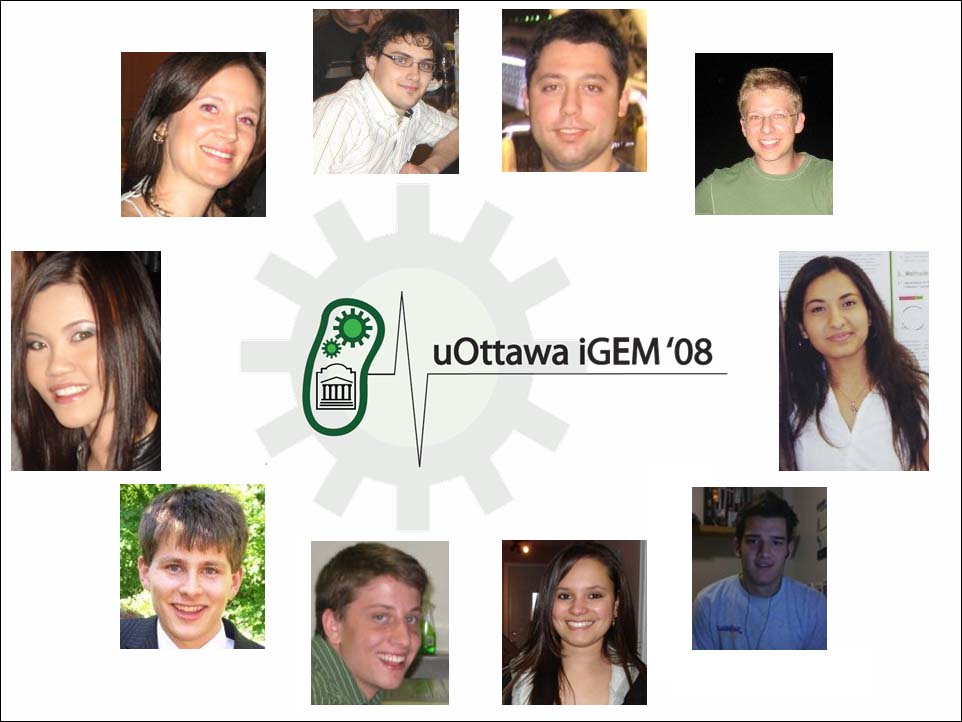Team:University of Ottawa
From 2008.igem.org
| Line 90: | Line 90: | ||
When large quantities of protein are required for industrial, pharmaceutical and research purposes, researchers may resort to expression of the loci of interest in a genetically modified organism. Once these transgenic organisms are built, they will be grown to sufficient titer before undergoing extraction for the protein of interest. In the case of microorganisms, this is performed in large bioreactors, where the protein of interest will be extracted from a continuously growing cell culture. When the protein of interest is excessively large or toxic to the cell, synthesis by the organism is difficult, and the use of bioreactors is limited. In the bioreactor, a small subpopulation of cells emerges, where the cells are not expressing the protein correctly. This subpopulation soon dominates due to positive selective pressure, and the use of the bioreactor becomes less effective with time. After a couple of months, the bioreactor will become inefficient, and will have to be “restarted”, a long and costly process. The goal of this year’s uOttawa iGEM team consists of generating a yeast strain capable of long term protein expression. | When large quantities of protein are required for industrial, pharmaceutical and research purposes, researchers may resort to expression of the loci of interest in a genetically modified organism. Once these transgenic organisms are built, they will be grown to sufficient titer before undergoing extraction for the protein of interest. In the case of microorganisms, this is performed in large bioreactors, where the protein of interest will be extracted from a continuously growing cell culture. When the protein of interest is excessively large or toxic to the cell, synthesis by the organism is difficult, and the use of bioreactors is limited. In the bioreactor, a small subpopulation of cells emerges, where the cells are not expressing the protein correctly. This subpopulation soon dominates due to positive selective pressure, and the use of the bioreactor becomes less effective with time. After a couple of months, the bioreactor will become inefficient, and will have to be “restarted”, a long and costly process. The goal of this year’s uOttawa iGEM team consists of generating a yeast strain capable of long term protein expression. | ||
| - | + | <html> | |
| + | <object width="425" height="344"><param name="movie" value="http://www.youtube.com/v/7xU0wBG9u7A&hl=en&fs=1"></param><param name="allowFullScreen" value="true"></param><embed src="http://www.youtube.com/v/7xU0wBG9u7A&hl=en&fs=1" type="application/x-shockwave-flash" allowfullscreen="true" width="425" height="344"></embed></object> | ||
| + | </html> | ||
| Line 119: | Line 121: | ||
:November 8-9 | :November 8-9 | ||
::<li>'''iGEM Competition Jamboree, MIT, USA''' | ::<li>'''iGEM Competition Jamboree, MIT, USA''' | ||
| - | |||
| - | |||
<html> | <html> | ||
Revision as of 20:45, 23 July 2008
Contents |
Welcome to the uOttawa Team Wiki!
We are a team consisting of 3 scientific advisors and 12 undergraduate students from the University of Ottawa. This is the first year that the University of Ottawa has recruited a team to participate in the iGem competition. Our team members have a variety of backgrounds and areas of expertise. Feel free to take a look at our team page to find out more about us.

|
Announcements
Project Description
When large quantities of protein are required for industrial, pharmaceutical and research purposes, researchers may resort to expression of the loci of interest in a genetically modified organism. Once these transgenic organisms are built, they will be grown to sufficient titer before undergoing extraction for the protein of interest. In the case of microorganisms, this is performed in large bioreactors, where the protein of interest will be extracted from a continuously growing cell culture. When the protein of interest is excessively large or toxic to the cell, synthesis by the organism is difficult, and the use of bioreactors is limited. In the bioreactor, a small subpopulation of cells emerges, where the cells are not expressing the protein correctly. This subpopulation soon dominates due to positive selective pressure, and the use of the bioreactor becomes less effective with time. After a couple of months, the bioreactor will become inefficient, and will have to be “restarted”, a long and costly process. The goal of this year’s uOttawa iGEM team consists of generating a yeast strain capable of long term protein expression.
IGEM 2008 Calendar of Events
- April 18
- IGEM 2008 registration opens
- May 9
- IGEM 2008 registration closes
- May 15
- BioBrick parts sent to teams
- Preliminary team rosters due
- May 3
- Teachers Workshop, MIT, USA
- July 1
- Team project descriptions due
- Team registration fee due
- September 1
- Final team rosters due
- September 17
- Jamboree attendance fee due
- October 1
- Notice and description of any use of non-standard parts or devices schemes due
- October 15
- Project Summary forms due
- October 29
- Project and part documentation due, including documentation for all medal criteria
- BioBrick Part DNA received by the Registry
- November 8-9
- iGEM Competition Jamboree, MIT, USA
 "
"
